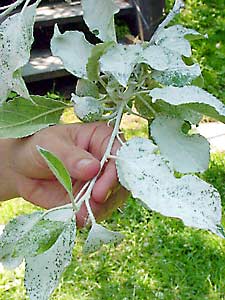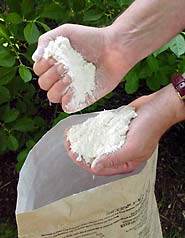

Beginning in spring of 2001, gardeners have an important new tool to protect their plants from pests. Best of all, it's a familiar and completely safe material, kaolin clay, a common ingredient of both toothpaste and aspirin as well as a host of common products such as ceramics, paints, and papers. Most Americans probably know kaolin best as one of the key ingredients of the medicine Kaopectate. So how did such a familiar material become the lastest hot item in pest control?
In the early 1990s, the USDA's Agricultural Research Service scientists Drs. Michael Glenn and Gary Puterka, Kearneysville, West Virginia, were charged with finding less toxic alternatives to the chemicals used in orchards. They knew that using dusts to repel insects has an ancient history, and that talcum, mica, and kaolin dusts had been studied for agriculture as far back as 1928.
But unlike researchers of 70 years ago, Glenn and Puterka had the help of New Jersey-based Engelhard Corporation, a company with expertise in surface chemistry and materials science. Engelhard developed a new material, a type of particle film using "engineered microscopic particulates to form a semicontinuous, porous barrier." They've trademarked the technology as HPF Technology, and the first product produced using it is Surround Crop Protectant. Engineered kaolin was chosen as the active ingredient because it meets size and shape specifications, is essentially non-toxic, and has specific light-reflecting qualities.
Surround works by coating plant surfaces with a powdery film. Some pests are repelled by the light reflected from the coated plant's surface; others simply don't recognize the host because it feels different. Further, the particles stick to pests and become a powerful enough irritant to make it leave. Finally, some pests simply can't hold onto the coated surface and fall to the ground.
Much of the initial field research involved apples and pears. Apple pests controlled by Surround include leafrollers and leafhoppers; codling moth, plum curculio, apple sucker, stink bugs, apple maggot, and thrips are suppressed. On pears, the difficult to manage pear psylla is controlled; thrips, leafhoppers, codling moth, stink bug, and mites are suppressed.
Among vegetable garden pests, use Surround against Japanese beetles, tarnished plant bugs, and Colorado potato beetles.
Because the material doesn't have an insecticidal effect, pest resistance is not a concern. It can be applied right up to the day of harvest, and simply washes or rubs off.

A positive side effect of the white film is its ability to reduce the ultra-violet and infrared rays that reach the plant, while allowing visible light and gasses through. Plants stay cooler and photosynthesize more efficiently, resulting in greater vigor and larger harvests, a key benefit in very hot, arid climates. Some growers reported yields twice as high on particle film treated crops compared to crops under conventional management. Encouraged by this, researchers are now working with a prototype film that protects plants from frost damage by creating a barrier between ice crystals and plants' tender tissues.
Surround may sound like a home garden panacea, but there are caveats. First, it must be applied as a preventative to be effective. It can't control a pest that's already established. Though in general it doesn't generally harm pests' natural enemies, researchers in one location found that it interfered with beneficial insects. But they are confident that with proper timing of sprays, particle films will be more helpful than not. The product is not labeled for use on crops that it cannot be cleaned from easily, such as lettuce. Researchers in cool, cloudy regions are testing the product to make sure light reduction doesn't adversely affect harvests.
Usually you can't tell where you've sprayed a crop with pesticide. But when you use this special particle film, marketed to home gardeners as Surround At Home, plants have an eerie, ghostly white look. But it's really only scary to the pests it foils.
Surround washes off, but not as readily as you might imagine. In fact, we found that it sticks surprisingly well, to leaves through rains but also to patio decks and furniture. We recommend you cover anything nearby that you don't want speckled with white.
You'll need about 1/2 pound or 3 cups of the material to make 1 gallon of spray, which is enough for one full size tree. Use any type of pressure sprayer, and shake the sprayer constantly to keep the mixture agitated and evenly distributed. It mixes well with most other pesticides with the exception of horticultural oil, and can even enhance their performance. Expect to pay between $3 and $5 a pound, depending upon quantity.
Barbara E. Richardson is a horticulturist and the community manager at National Gardening Association.
Photography by Sabin Gratz/National Gardening Association.
 Victory Seed Company has all the seeds you want for your best garden in 2024.
Victory Seed Company has all the seeds you want for your best garden in 2024.
For 25 years, the family-owned Victory Seed Company has provided the highest quality vegetable, herb and flower seeds to families across the country. We are passionate about providing you the best seeds available that give excellent germination, robust plants, and the harvest you want. With a catalog of over a thousand varieties, we have everything, and our prices are the kinds that we'd want to pay. We have hundreds of yesterday's heirloom vegetables, as well as today's award winning hybrid selections. Get to know us by visiting our website and browsing through our online vegetable seed catalog.